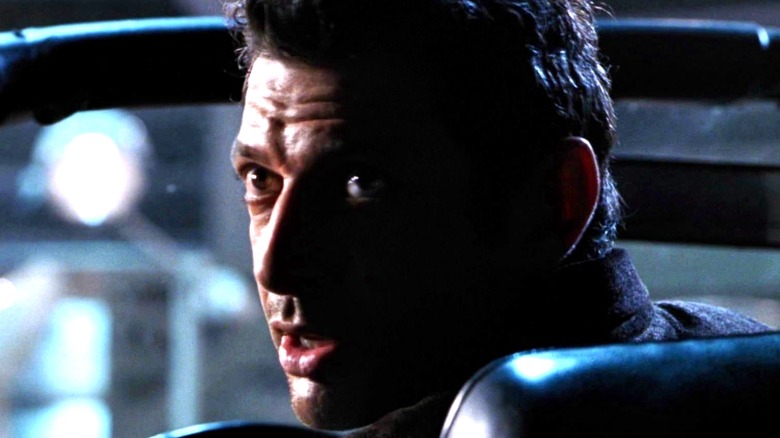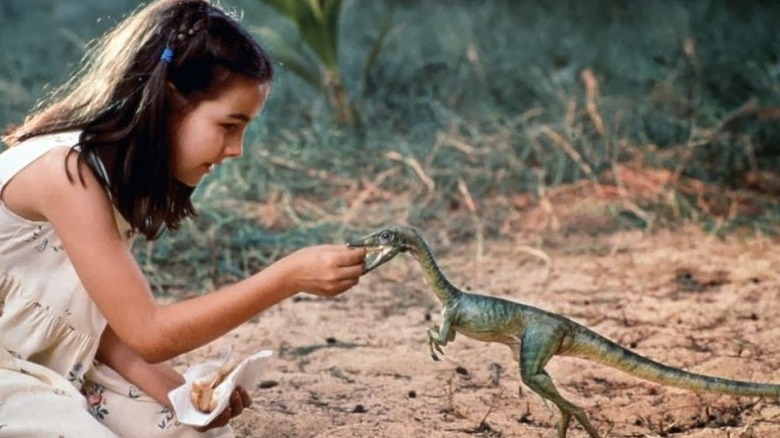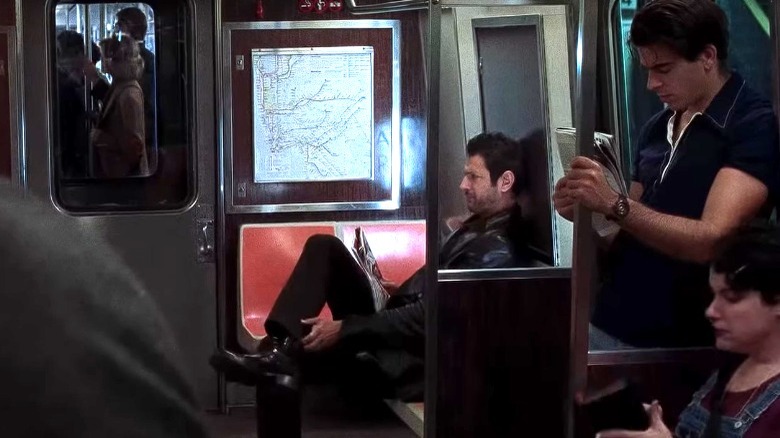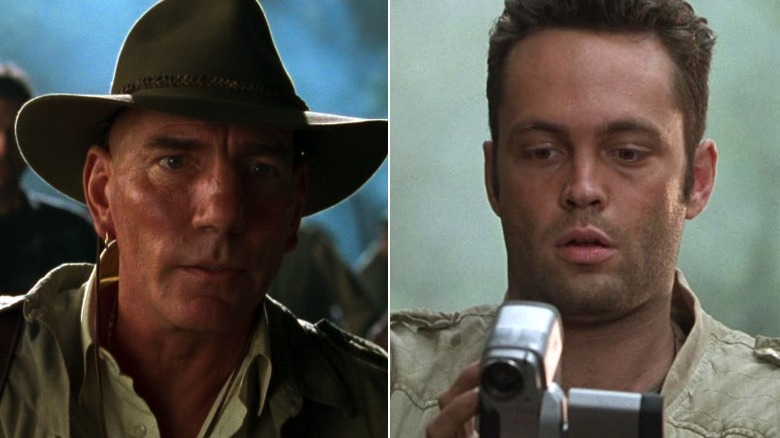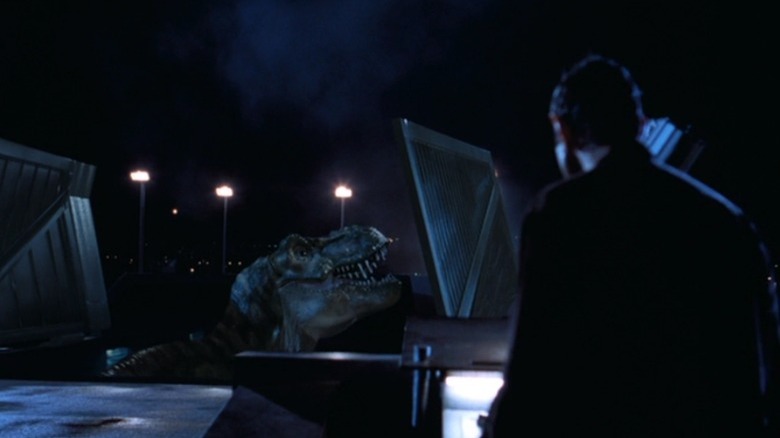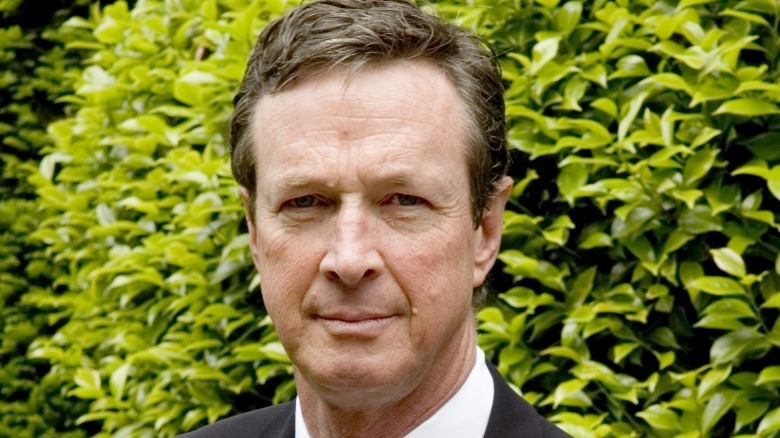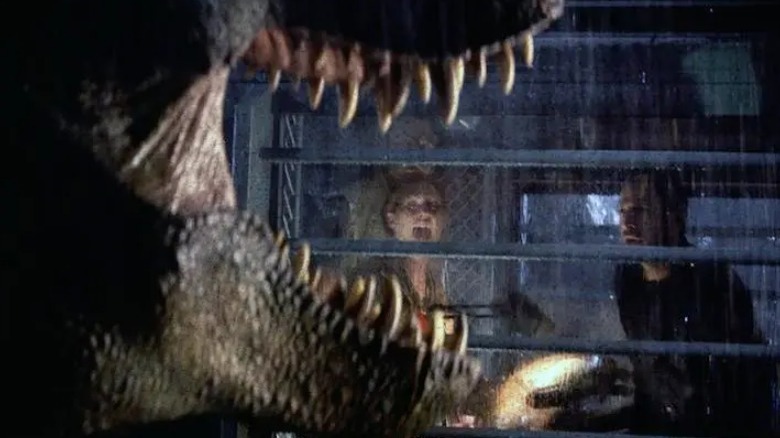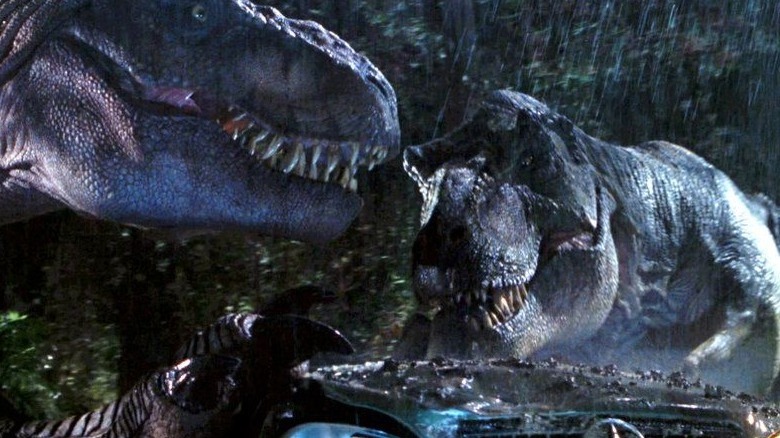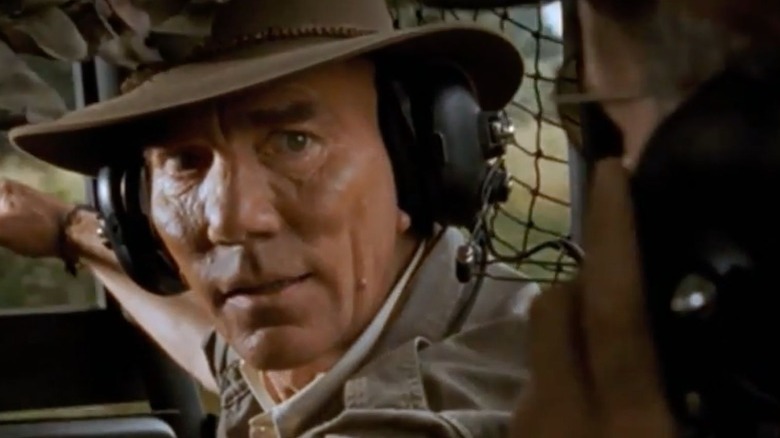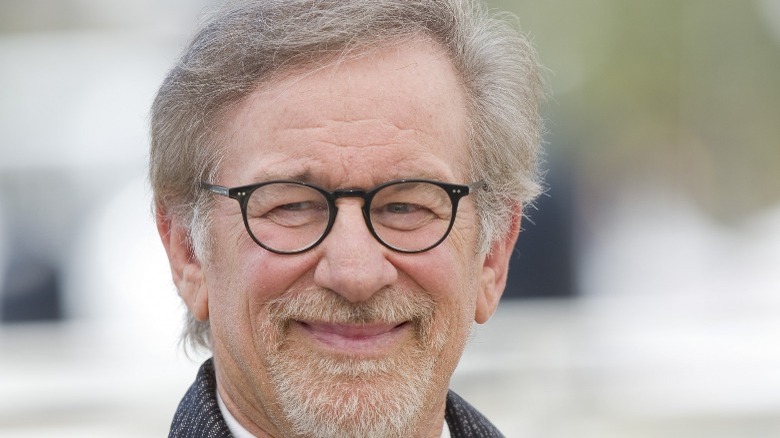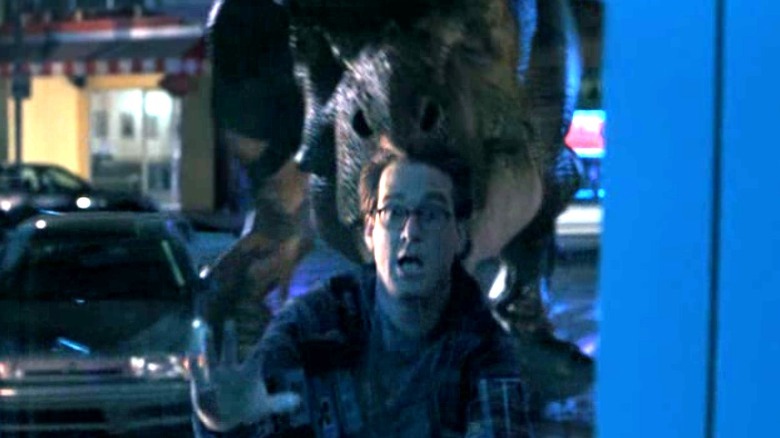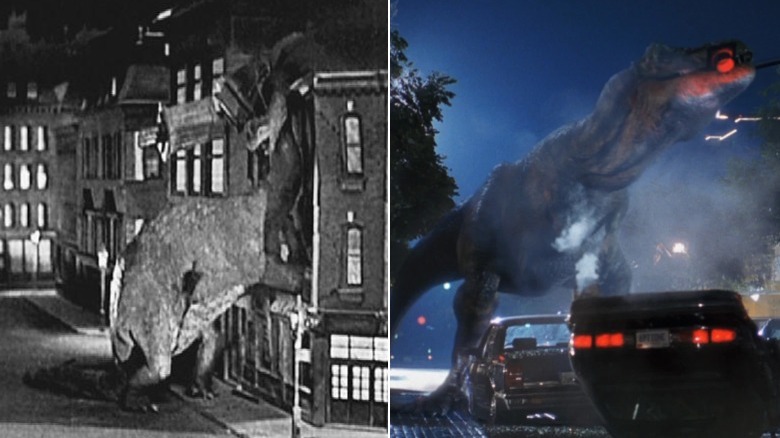Things You Probably Never Knew About The Lost World: Jurassic Park
Back in 1997, it was time to hold onto our tushes for dear life. We were in for double the mayhem, double the dinosaurs, and no expense spared in "The Lost World: Jurassic Park" — the sequel to Steven Spielberg's 1993 prehistoric romp, "Jurassic Park." For various reasons, numerous members of the original "Jurassic Park" cast did not return for the follow-up, but at least we got Ian Malcolm, played by Jeff Goldblum, back to inform us that "Mommy's very angry." That's right — this time around, we've got two T-rexes, who also happen to be fiercely proud parents, terrorizing the human element of this movie.
In terms of its production, "The Lost World" went a little bigger than its counterpart, adding $10 million to the "Jurassic Park" budget for a total of $73 million spent making "The Lost World." While it didn't quite reach the box office height of its predecessor, the film still managed to rake in a substantial amount of dough. As the years have passed, the film has been criticized for stripping away the scientific discussions that made the original fascinating in favor of capitalizing on a blockbuster focused on thrills and a war between a corporation and environmentalists. Regardless, critical takes don't always align with fandom. Let's examine the embattled sequel to the world's greatest dinosaur film and highlight some of the lesser-known facts behind "The Lost World."
The intro scene is from the original Jurassic Park novel
Nothing sets the stage for another morbid adventure steeped in dino-involved death like a pack of Compsognathus, or "Compies" for short, eyeing a young girl as a potential afternoon snack. A wealthy family parks their lavish yacht near the shore of Isla Sorna, a mysterious island near Costa Rica. Apparently, they want to relax on a random beach they know nothing about and enjoy brunch. Their young daughter does what all kids do and runs off to explore the beach. Soon she finds a small bipedal dinosaur no bigger than a chicken who she shares her snack with. Unfortunately, the dinner bell rings and all of the little guy's siblings, aunts, uncles, nephews, and cousins twice-removed line up for a small human-sized buffet. The girl is attacked, and her screams beckon her parents and their servants to come to her aid. Luckily, she survives the ordeal, as John Hammond mentions her survival a short while later.
As folks who've read "The Lost World" by Michael Crichton already know, the film rarely reflects the narrative of the book. Instead, this plot point actually occurs in Crichton's first "Jurassic Park" novel. It's a moment used to underscore the danger already emanating from John Hammond's theme park island, Isla Nublar, as the dinosaur population grows out of control right under the park security system's nose. The attack on the girl triggers the trepidation of Hammond's investors, so the billionaire attempts to ease their fears with approvals from field experts Alan Grant and Ellie Sattler.
Eli Roth portrays a man on a subway
Just like the folks working in all the other professional fields in our society, most A-list actors and big-time Hollywood figures had to begin their careers in minor capacities. Director of the "Hostel" trilogy and actor Eli Roth is one such talent. While you're likely to know him as the feared Bear Jew who's famous for taking homerun swings at of Nazi skulls in Quentin Tarantino's "Inglourious Basterds," you might also recognize him from a few films in the '90s ... if you look hard enough.
Roth partially began his career by taking roles as extras in big production films. He makes an appearance in "The Lost World" as a character IMDb lists as "Subway Man." In the above image, Roth is the handsome fellow standing and reading a newspaper to the right of Ian Malcolm, just like a real "Subway Man" would do. One day, after that young whippersnapper claws his way to the top, he'll have us all dry heaving from the cannibalistic horrors of "The Green Inferno."
Warren Zevon has a surprising influence on The Lost World
Did you ever watch "The Lost World" and think Vince Vaughn and Pete Postlethwaite's characters both have familiar-sounding names? If so, then you might be a fan of Warren Zevon. It happens to be the case that Roland Tembo (Postlethwaite) and Nick Van Owen (Vaughn) share a song.
In the film, Roland is a big game hunter aiming to bag the ultimate prize — a T-rex. Nick is the naturalist who's looking after the safety and care of the animals on the island. He even frees all of the dinos that Roland helps InGen capture by unlocking their cages. Nick and Roland are antagonistic toward one another, as you might expect considering their polar opposite ideals.
The tune "Roland the Headless Thompson Gunner" by Zevon tells the tale of a CIA operative named Roland assigned to aid those in the Congo during the bloody battles that ensued from a historical crisis in the embattled nation. According to the song, Roland was a beast and at the top of his league. The CIA saw him as a threat and sent a comrade of his by the name of Van Owen to kill him in cold blood. Van Owen completed his mission by blowing Roland's head clean off. Of course, the headless spirit of Roland later haunts and exacts vengeance upon Van Owen. It's a grisly song that creates its own epic legend. Screenwriter David Koepp confirmed that the two characters were, in fact, named after the rivalry from this song. A guy might get bisected by two hungry Tyrannosaurs, but at least nobody gets their heads blown off in "The Lost World," despite this cheeky reference.
King Kong makes a secret appearance
Clearly, Steven Spielberg has an affinity for Hollywood icons of the past. The first "Jurassic Park" includes Ian Malcolm making a wise crack about the massive primal gates of the theme park potentially harboring a beast like King Kong behind them. "The Lost World" doesn't slow down with its references to Earth's mightiest kaiju-sized gorilla.
In the third act of the film, Roland Tembo finally captures his mark — a Tyrannosaur. The T-rex is hit with multiple tranquilizer darts that keep it sedated during its transport on an ocean vessel setting sail for San Diego. The ship that transports the carnivore is named the SS Venture — a clear reference to the ship of the same name that carries King Kong to the mainland in 1933's "King Kong." Both ships leave legacies of carrying wildly exotic creatures that escape once they arrive on the mainland and terrorize a densely populated urban environment fully of tasty human morsels.
Fans convinced Michael Crichton to write a sequel
After the wild success of "Jurassic Park," both as a novel and a feature film, author Michael Crichton began fielding questions about a possible sequel. The author had never written a sequel before and wasn't entirely fond of the idea. Initially, he shut down the prospect. In an interview with Charlie Rose, Crichton laid out a seemingly airtight explanation for why he had never written a sequel before. He posited that a solid sequel has to be the same but different. The juxtaposition of those ideas contradicted each other radically in his mind; either a story is a redundant continuation of an existing work, or it's truly different and therefore isn't a sequel at all.
Ultimately, Crichton was convinced by the "Jurassic Park" fandom that there could be more to the saga. In fact, he decided it would be important to tell a story that stepped away from the DNA and genetics aspects of the first story and was rooted in themes of population, evolution, and extinction. Rose even asked Crichton the poignant question of whether he believes humanity is on the road to extinction, to which Crichton affirmed the likelihood, considering that most species meet an end at some point. He suggested that the changes in human behavior over time drastically change the trajectory of the species as a whole, much as was once the case for the dinosaurs.
The film kind of ignores Crichton's novel
After the fans did the leg work of persuading Michael Crichton to create a sequel to his hit novel, Steven Spielberg and Universal Studios were ready and willing to move forward with an adaptation. However, fans who've read Crichton's "The Lost World" and have seen the film it's supposedly based on will note that the two are wildly different stories with some similar character details.
The barebones premise remains intact. The idea of a second island — Isla Sorna, or "Site B" as designated by InGen — is the forefront of both the novel and the film. Additionally, even though Ian Malcolm seemingly dies in the first novel, the sequel resurrects him with a bit of slick writing regarding his medical status. Spielberg and screenwriter David Koepp had established some of their own ideas for the sequel, but used the initial setup that Crichton provided. The only major scene that's truly ripped out of the novel is the dual T-rex attack on the trailers at the cliff's edge. Beyond that, the filmmakers clearly drew inspiration from Crichton's earlier work in "Jurassic Park," including story elements from that novel that didn't make it into the original film. In addition to the attack on the Bowman family, John Hammond's death in the first novel due to an onslaught of tiny bites from a pack of wild Compsognathus is reserved for the film character of Dieter Stark. The plot to bring dinosaurs to the mainland for a new attraction is an entirely separate narrative from the novel.
The T-rex animatronics actually slammed into the trailer
The mixture of computer animation and practical effects in both "Jurassic Park" movies help make viewers feel like they're close to the action. Correctly presuming that actual animatronic dinos the actors could touch could add even more realism to "The Lost World," the studio commissioned the construction of two full-grown T-rex animatronics. During filming, the robotic pseudo-animals were moved along tracks so they could be placed where they needed to be.
The designer behind the T-rex rigs, Shane Mahan, described what it was like filming with the monstrosities. "I think out of everything on this movie, we had the most fun smashing up the RV with the two T-rexes. At first, we were hesitant, thinking that we had to be careful with the rigs. But it got to the point where were just, 'Ah, to hell with it,' and we just demolished that trailer with the T-rex rigs. That scene wasn't faked. Those T-rexes were really slamming into that thing, breaking glass and shaking it."
It doesn't get much more realistic than that. While many instances of large-scale destruction and violence in films are created with animation technology, this moment stands as a true cinematic marvel — one that is rare in film these days.
Roland's true story about the man who climbed Mount Everest
Roland Tembo and Nick Van Owen have an antagonistic relationship, but Roland doesn't get along with a lot of people. In fact, Roland also doesn't much care for his corporate employers. He even forgoes payment specifically to ensure an arrangement where the expedition is carried out on his terms. Principally, he's interested in hunting a Tyrannosaur. As a big game hunter, Roland often seeks the thrill and sport of stalking the world's most fearsome predators. Nick, on other hand, can't fathom Roland's desire to kill a creature that has been resurrected after millions of years of extinction. Nick is a naturalist, focused on preserving animal life and their habitats.
During their journey together, Roland tries to explain his philosophy to Nick. Roland references a climber from a couple decades prior who climbed Mount Everest without any supplemental oxygen. As breathing gets more difficult at higher altitudes, making the trek up Everest without any extra oxygen is generally considered highly unwise. The man returned from his adventure near death and was asked why he climbed the peak just to die. The man responded that he made the climb to live.
Roland's story is, in fact, a true story. A man by the name of Reinhold Messner and his compadre Peter Habeler made the climb in 1978 at a time when such a feat was thought impossible. Regardless, both men believed they'd survive against the odds and managed to do so. Clearly, Roland feels a sense of kinship with the intrepid explorers.
Spielberg appears in the reflection of a TV
"The Lost World" is littered with easter eggs and references. In one third-act scene at a Blockbuster, viewers can see fun faux-movies for rent that star Robin Williams and Arnold Schwarzenegger.
However, there's another great moment at the end of the film that's most definitely worth a pause to truly appreciate. Steven Spielberg is one of the most revered directors in the industry, and his likeness is known almost as well as the celebrity actors he employs. After the T-rex is sent back to its home on Isla Sorna aboard the SS Venture, the journey is broadcast on television. Ian, Sarah, and Kelly are sitting exhausted on their couch watching the news unfold. However, during a shot that simply shows the TV screen, viewers can see Spielberg himself is actually sitting with the crew on the couch in the screen's reflection. It's a fun accidental cameo that most people won't notice unless they're looking for it.
The screenwriter has a cameo as T-rex food
The first "Jurassic Park" was a juggernaut at the box office, leaving the second film with big shoes to fill. The demand for more "Jurassic Park" was strong, and with a box office haul topping $1 billion, it was clear that fans wanted more dinosaurs and carnage. Crichton completed the sequel novel he had envisioned, but screenwriter David Koepp was working closely with director Steven Spielberg on writing the screenplay. Much of that screenplay contained original ideas that didn't have any ties to the book the film was based on. While Crichton helped with the screenplay for the first film, Koepp is the sole credited screenwriter for "The Lost World," indicating that he had a massive influence over how the film turned out.
After the T-rex is unleashed on San Diego in the third act of "The Lost World," civilians can be seen running from the dinosaur as if they were in a Godzilla film. In one such sequence, a sole citizen breaks off from the herd of people bolting away from the animal and tries to rush indoors. Unfortunately, the doors are locked, and the T-rex turns and takes a big chomp out of the poor fellow. That fellow is played by Koepp. His death sequence includes possibly the most hilarious-sounding death scream in the entire film. Koepp is actually a credited actor in the film, portraying a character named "Unlucky Bastard." "Unlucky" might be putting it mildly.
The Lost World of 1925 gets a homage
The sight of a T-rex stomping through San Diego is a wild shift from the more pensive, horror-centric tone of the jungles of Isla Sorna. While some might feel the sequence gratuitous or ham-fisted, it's actually an appropriate homage to 1925's "The Lost World," a film based off the work of Arthur Conan Doyle. Of course, Spielberg's film adds the subtitle "Jurassic Park" for brand recognition, but also to differentiate the movie from the classic film and novel of the same name.
In the 1925 movie, the film's protagonists attempt to bring a Brontosaurus to London simply for the spectacle and proof of their voyage. However, during its offloading from the ship, the beast is terrified and goes on a rampage wreaking havoc through London. Of course, a Brontosaurus is an herbivore, so while it might cause an substantial amount of damage stopping around buildings, it isn't attempting to eat anybody. The T-rex obviously raises the stakes for the filmmakers, the audience, and the characters in the film. But make no mistake — the connection between these similarly named films wasn't just a coincidence.
